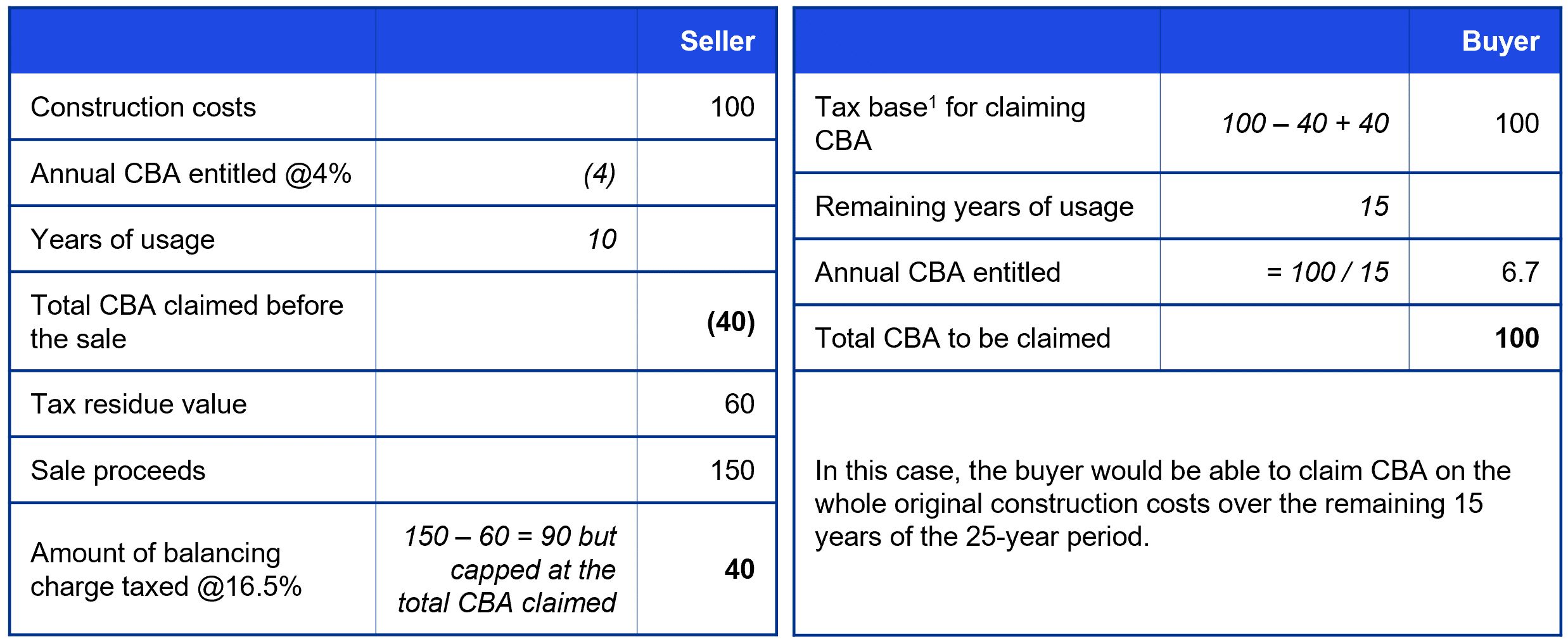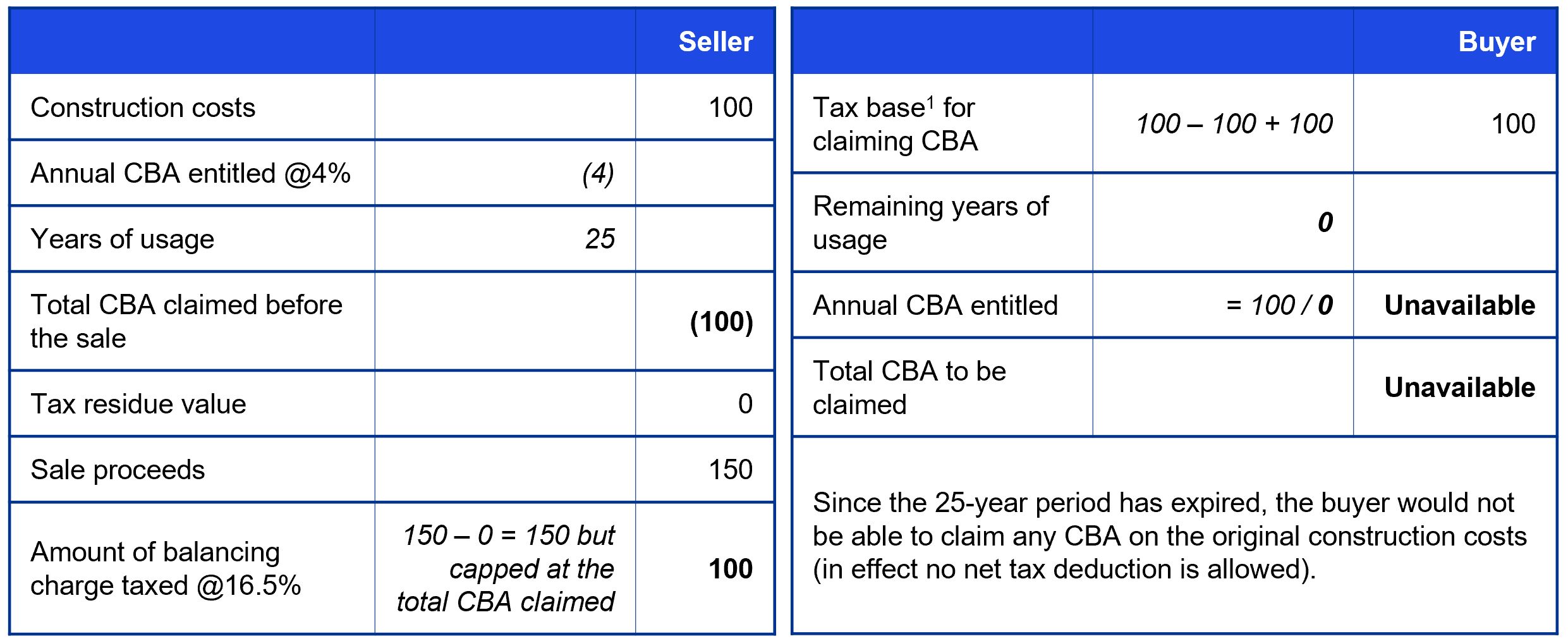Summary
Under the existing tax depreciation regime for commercial buildings (i.e. commercial building allowances (CBA)) in Hong Kong, asymmetric profits tax treatments may arise when a commercial building that has been in use for more than 25 years is sold. In this situation, the seller is subject to a claw-back of the CBA previously granted to it but the buyer is unable to claim any CBA on the construction cost of the building as the new owner.
This issue is becoming more pressing as the end of the reset 25-year period for those commercial buildings put in use prior to year of assessment (YOA) 1998/99 is fast approaching (i.e. YOA 2023/24).
In this news alert, we look at this issue in more detail and discuss the possible options to address the issue that we have put forward for the HKSAR Government’s consideration.
Background of the issue
The existing CBA regime
Under the current CBA regime, annual allowances at 4% of the construction costs of a commercial building are granted to Hong Kong taxpayers as a tax relief for the construction costs incurred. The annual allowances can be claimed by taxpayers over a maximum period of 25 years starting from the YOA in which the building was first used or YOA 1998/99 (for commercial buildings constructed prior to YOA 1998/99).
When a taxpayer subsequently sells a commercial building and the amount of consideration received by the taxpayer is greater than the tax residual value of the building immediately before the sale, the excess is taxable as a balancing charge, subject to a cap of the total CBA previously granted. The balancing charge effectively represents a claw-back of the CBA previously allowed to the taxpayer.
Correspondingly, the buyer can claim CBA on the tax residual value plus any balancing charge in respect of the building acquired for the remaining year(s) (if any) within the 25-year period. However, no CBA would be granted to the buyer if the commercial building has been put in use for more than 25 years – that is when the 25-year period has expired.
Property owners and investors will need to fact this issue into their investment modelling going forwards.
In our view, it is a peculiar outcome that gives rise to an issue of fairness to taxpayers. This has become an imminent issue for commercial buildings that were constructed before YOA 1998/99 as for these buildings, the counting of the 25-year period started from YOA 1998/99 and will expire by YOA 2023/24 (i.e. YOA 2023/24 will be the last YOA in which CBA on such buildings can be claimed).
Numerical examples for illustration
The two numerical examples below provide an illustration of the issue.
Scenario 1: When a commercial building was sold before the expiry of the 25-year period (e.g. after 10 years of usage)

Scenario 2: When a commercial building was sold after the expiry of the 25-year period

KPMG observations and recommendations
The issue could largely be addressed if it is agreed that the Inland Revenue Department (IRD) accepts that the majority of the sale proceeds represents an appreciation of the land value and only a small portion of the proceeds is attributable to the building. However, the IRD does not in practice accept this position.
To promote greater fairness of the Hong Kong tax system, we made a submission to the HKSAR Government in June this year and set out the following possible options for addressing the issue for the government’s consideration:

While the effect and outcome of the three options above are different, the total amount of CBA granted in all of the three suggested options above would be limited to the original construction cost of the building.
A similar issue also arises for aged industrial buildings in Hong Kong because under the existing industrial building allowances (IBA) regime, there is also a 25-year time limit for claiming IBA on industrial buildings. However, as there are fewer industrial buildings than commercial buildings2 in Hong Kong, the magnitude of the issue and the impact on taxpayers may not be as significant as in the case of commercial buildings.
We look forward to receiving a positive response from the government and further discussing the issue with it to identify a solution that best strikes a balance between managing the impact on government revenue and promoting greater fairness to taxpayers.
In the meantime, taxpayers planning to purchase an old building in Hong Kong or transfer such a building within the group (for restructuring purpose or for addressing the potential impact of Pillar 2 under BEPS 2.0 on the group that would arise from the future realised gains upon disposal of the building) may want to explore whether it is commercially feasible and desirable to complete the transaction before the expiry of the 25-year limitation period of the building concerned.
1 Tax base = Original construction costs – total annual allowances granted + balancing charge
2 In our experience, most industrial buildings have been converted to commercial uses such as logistics or storage warehouses.
Connect with us
- Find office locations kpmg.findOfficeLocations
- kpmg.emailUs
- Social media @ KPMG kpmg.socialMedia



